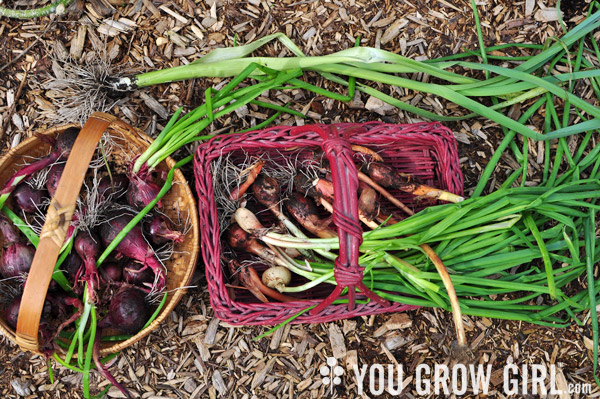
I have a “stick them wherever they’ll fit” attitude towards onions, shallots, garlic, and leeks. While most edible alliums grow to be their biggest and best when the soil is rich and the sun is bright, I often start the season with more allium seedlings and sets than ideal space in which to plant them. Rather than tossing the surplus away into the compost bin, I tuck them into any little space I can find, regardless of the growing conditions. The end of the season is like a treasure hunt as I gather these little treats from their hiding spaces underneath bushes, alongside taller crops that grew and shaded them out, and even stuck into pots.
Why Bother?
Planting onions, shallots, and the like is work, but it’s easy, quick work, and in the case of plants like the ‘Egyptian Walking’ onion, the work is not much more than tossing the topsets down and leaving them to find their own way. The harvest that is produced, especially from the bulbing types is smaller, sometimes significantly so than average so it is important to adjust your expectations. Still, I find the crop viable and worth the bother. With some careful consideration to placement you can use these plants as repellant insect-repelling companions and recoup your time in that way too.
The photo above represents just some of the harvest I collected the other day. I find these onions won’t last as long as their mature, sun-ripened counterparts so I use them up first. The little leek found its way into a recent meal (on top of salmon cooked in parchment), and I’ve used some of the red onions and their fresh greens to make my new food obsession: open-faced sardine salad sandwiches. In case you’re interested, I’ve made this two ways so far: once following this recipe, and the second was my own riff using fresh tarragon and lemon savory (Micromeria biflora) from my garden. [p.s. The sardines I’ve been buying are from Raincoast Trading and Oceanwise recommended. This is not a sponsored link, I simply bring it up as a way to support purchasing sustainably harvested seafood.]
Thanks for reminding me! I stashed extra onions near several different roses in an attempt to deter pests. I never went back for them. It will be the first chore when the rain lets up.
I share your attitude, too. I even use them to edge the garden, to deter marauding animals. But like Beverly, I’d better get out there and pull them up soon.
That’s a great idea. I never seem to have enough onions at the end of the season, when I always wish I’d grown more. I’m determined to have more next year. So thanks for the tip for what to do with any extras.
Do you have any suggestions for ways to use the greens (recipes)? I usually eat them in potatoes like chives or other such thing but right now I’m over run with them and don’t want most to go to waste.
We had a pile of walking onions last year. We ended up slicing and drying the vast majority of them, and then used them after we finished all the fresh walla walla onions from the garden. I also like sprinkling the dried bits on a bagel with cream cheese – I really like the onion-y crunch.